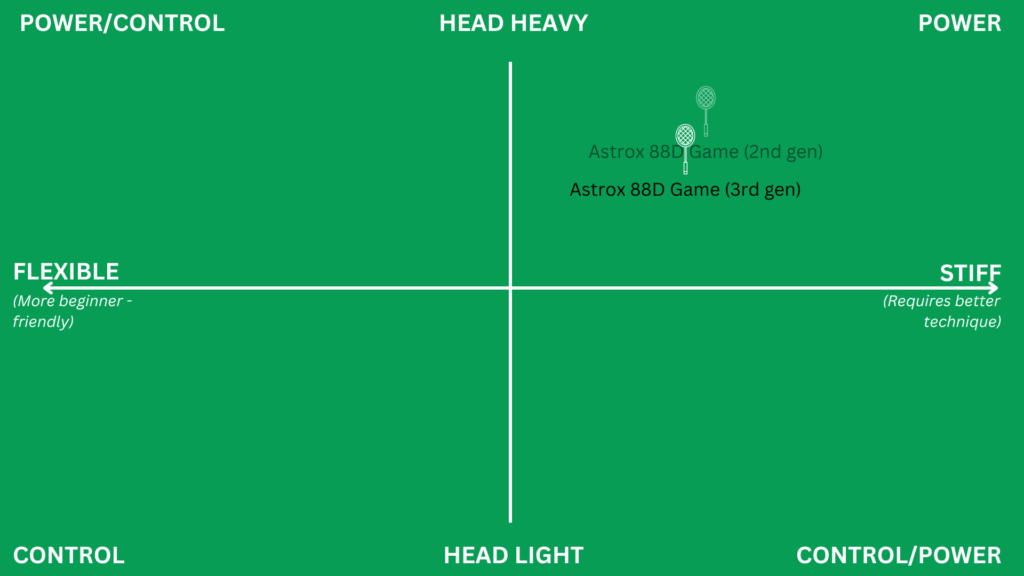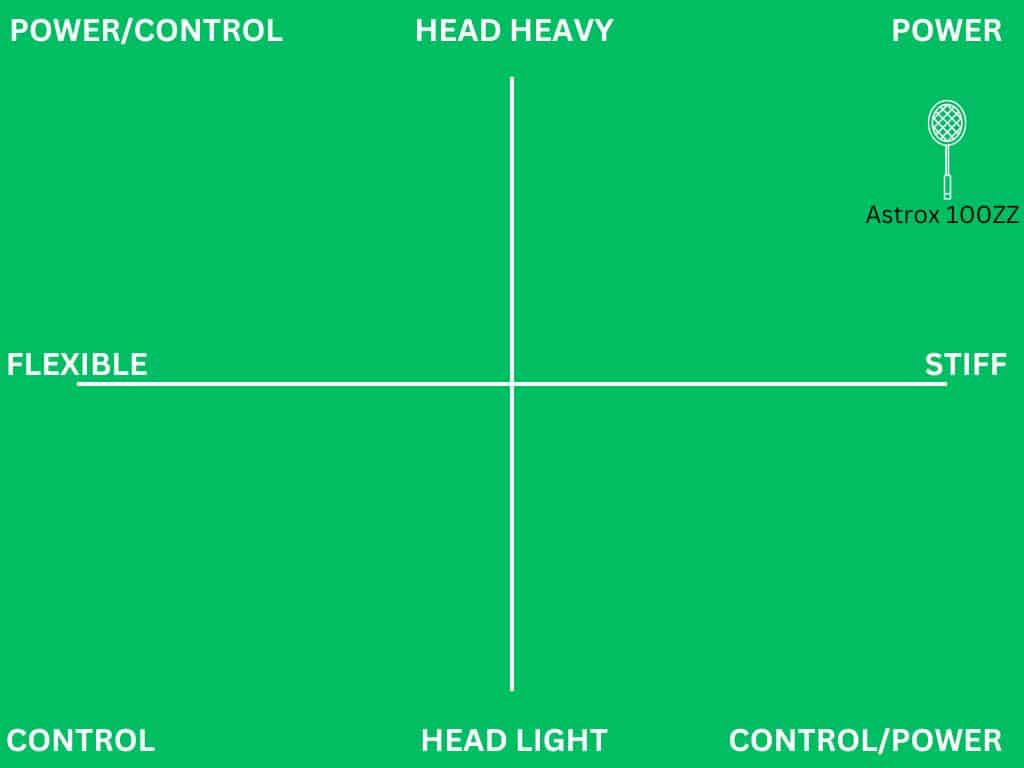Head heavy badminton rackets have historically been recognized for their power generation on shots like smashes and clears.
In many video games, gear often comes without any downsides. That isn’t the case with badminton rackets: you’ll usually have head heavy badminton rackets with more power, or head light ones with less power, but greater speed to move through the air.
New ideas and technology make the right racket choice even more complex nowadays, as some head heavy rackets are surprisingly fast and suitable as all-around rackets, even in doubles.
I’ve liked head heavy rackets in the past, but it took me some time to figure out what’s best for singles vs. doubles games.
The classic singles playing style, which many new players are attracted to, focuses on a killer smash and is easy to understand.
An adapted version for doubles with a similar type of player at the rear court is also easy to grasp, but it becomes murkier when that same player has to cover the front court. Suddenly, that same power racket becomes less useful, and a pattern might develop where that player continues to lose points.
Skilled opponents will turn that into a tactic attempting to force that rear player to the front court and exploit their obvious weakness, so we are forced into some sort of alternative.
During the same game, the player with the head heavy racket might get more tired in their arm and shoulder as each swing requires more force than if the racket’s weight balance is even or placed towards the handle. That same player can especially get in trouble during fast drive duels, which are common in doubles games.
This has led to a wide variety of head heavy badminton rackets. Some are leaning more towards even balanced weight, in a lighter weight class, or with thinner frames to compensate with a faster swing and easier maneuverability.
The 3U (heavier) weight class is more popular among singles players, whereas the 4U (lighter) is more popular among doubles players when it comes to head heavy badminton rackets.
- Rackets tested for this guide: 15
- Hours testing rackets on court: 150+ hours
- Updated: 13. Juli 2025
Four of the best head heavy badminton rackets right now
Each of the popular badminton racket brands has its own series focusing specifically on head heavy and power-based rackets.
Yonex has its Astrox series (before that, it was the Voltric series). Victor, the Thruster series, and Li-Ning, the Axforce series.
With the background out of the way, let me introduce you to the four head heavy badminton rackets.
Hey reader, a quick interruption I’m experimenting partnering with webshops that sell badminton gear, like Amazon. I’ll include links to buy the gear I review and if you do, they’ll pay me a small commission. That doesn’t change your price and you’ll get more play-tested gear as a result but I thought it was fair to let you know. As an Amazon Associate, I earn from qualifying purchases. I appreciate your support, Aske
1. Power and speed for intermediate players: Yonex Astrox 88D Game, 3rd gen. (~$100-$125 on Amazon)
The best head heavy badminton rackets for advanced players:
2. The doubles rear court destroyer: Yonex Astrox 88D Pro, 3rd gen. (~$200-$250 on Amazon)
3. The singles sledgehammer slammer: Yonex Astrox 100ZZ (~$200-$250 on Amazon)
4. The all-arounder: Yonex Astrox 77 Pro at Amazon (~$200-$250 on Amazon)
Table of Contents
1. Power and speed for intermediate players: Yonex Astrox 88D Game (3rd gen.)

Due to physics, you can usually only get a powerful but slower racket, or vice versa. So, how is it possible to get both in this one?
There’s no such thing as no downsides to a badminton racket, only trade-offs. In the 3rd gen of this popular rearcourt doubles racket from 2024, the power is dialed back slightly by making the head less heavy.
That naturally makes it easier and faster to swing. It’s slightly smaller frame helps too. The trade-off is the smaller sweet spot that makes it more challenging to hit the shuttle cleanly.
Hitting your shots cleanly is critical, but I didn’t find it to be much of an issue. If you’re curious about the Astrox 88D Game and wanna dive deeper, my Yonex Astrox 88D Game review is available here.
2. The doubles rear court destroyer: Yonex Astrox 88D Pro (3rd gen)
I haven’t had the chance to test the 3rd generation of the Yonex Astrox 88D Pro (from 2024) as it’s too difficult for me to play with, so instead, I’ve gathered the consensus of what other players seem to think about it.
It’s the intended rearcourt sibling of the Yonex Astrox 88S Pro and not ideal for beginners as the shaft is stiff. But if your technique is up for the challenge, you’re looking at a pretty fast head heavy racket that can handle net play when necessary.
While the Astrox 88S Pro has some power as the front-court sibling, the Astrox 88D Pro packs it heavy and makes clears and smashes a breeze.
If you’re looking at a head heavy badminton racket that isn’t going all in on power, this might be an option worth considering.
3. The singles sledgehammer slammer: Yonex Astrox 100ZZ

The Yonex Astrox 100ZZ is Yonex’ flagship power racket and has been Viktor Axelsen’s preferred choice while dominating the singles category.
Since this racket is intended for advanced players and above, I haven’t had the privilege of testing it on court – it’s too challenging for me to tame just yet. Instead, I’ve gathered the consensus of what other players seem to think about it.
Where the old Voltric Z-Force 2 represented old school hulk-like raw power with all the benefits and disadvantages of a traditional superhero, the 100ZZ is more complex.
It’s reported to pack slightly less raw power during easy power smashes where you’re not under pressure. In more common situations where you are under pressure, though, the 100ZZ makes it easier to generate the power you’d expect from the best head heavy badminton rackets.
That means it’s less likely to wreck your game as there’ll be more opportunities to use it without getting in trouble when under pressure, and strong players can still leverage their strength to generate power with this racket.
In comparison, the Astrox 88D Pro handles slightly better as it has a lighter head, but the 100ZZ is still fairly easy to play with, considering how powerful it is. Its slightly smaller sweet spot doesn’t affect its playability, and it has a good soft feeling when the shuttle hits the racket.
The ZZ (high-end) version of this racket has an extra stiff shaft and is not for beginners. If you’re a beginner and intrigued, the 100 Game is a better bet (although it’s also too difficult to control for most beginners). Here’s my Astrox 100 Game review.
4. The all-arounder: Yonex Astrox 77 Pro

As a reference point, the Yonex Astrox 77 Pro is faster than the Astrox 88D Pro and perfect for the player who likes a bit of head weight. It’s leaning towards even balanced rackets and Yonex’s Arcsaber line, but that bit more power.
The medium flexible shaft is unusual for Yonex’s pro-edition rackets and makes them slightly easier to play with that other Pro-rackets, if you’re at the intermediate level without polished stroke skills.
But unless you’re at the mid-intermediate or above, you’ll likely find it too stiff when things get intense on court. For that reason, they don’t have a Game edition in this lineup, which is Yonex’s typical intermediate model within a racket series. It also comes in different budget versions: the Astrox 77 Play for beginners and the more affordable Pro-edition clone called Astrox 77 Tour.
You’ll probably like this racket if you’re looking for something with power that leans towards the even balanced rackets. Read my full Yonex Astrox 77 Pro review here.
Frequently asked questions about head heavy badminton rackets (FAQ)
A head heavy badminton racket is good for power, meaning smash, clears, and getting out of trouble with the backhand which is often especially suitable in singles games. However, nowadays, many head heavy rackets are made slightly lighter and faster to suit front court doubles play as well.
Whether head heavy rackets are good depends on your playing style as there are strengths and weaknesses to both. The typical strength for a head heavy racket is power, whereas the downside often is a lack of speed.
Yes, a head heavy racket is good for smash as it transfers more power into the shuttle like a hammer onto a nail as opposed to a head light racket that offers speed and maneuverability.
The difference between a head heavy and head light racket in badminton is where the balance point is placed. It either has more weight at the head (head heavy), which leads to more power in the shots such as your smash.
On the other hand, a head light racket is faster to swing in the air so you’ll be ready for quick follow up shots faster, which is common in doubles games.